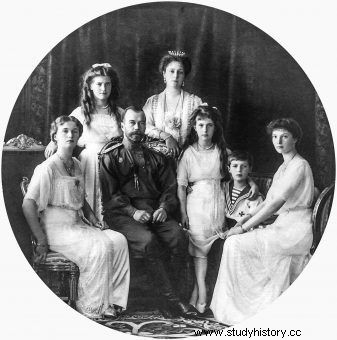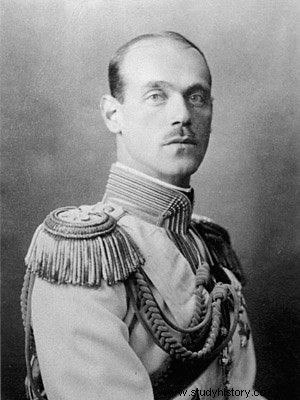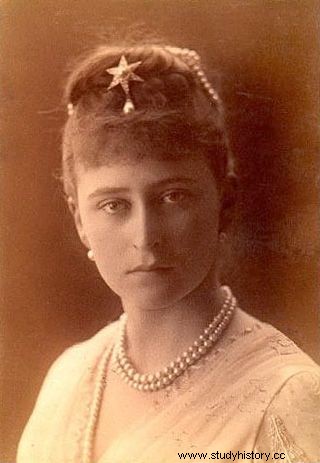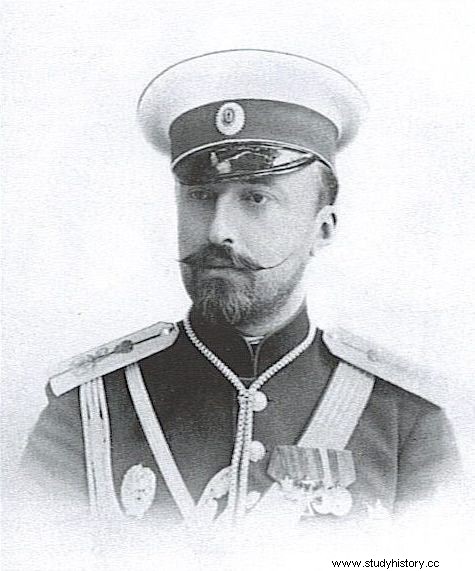In 1918-1919, the Bolsheviks brutally murdered not only Nicholas II, his wife Aleksandra and their five children, but also 11 other family members. To this day, the burial place of 10 of them remains unknown.
The Romanovs began to lose their sense of security immediately after the abdication of Nicholas II, which took place on March 15 (2), 1917. As soon as they appeared on the streets of St. Petersburg or any other Russian city, insults and threats would fly in their direction. Grand Duchess Maria Pavlovna, the cousin of Nicholas II, who worked as a rank-and-file nurse in a military hospital, was forced to leave the facility due to the reluctance of her associates.

Tsar Nicholas II with his family. From the left, Olga, Maria, wife of Alexander Fyodorovna, Anastazja, Alexei and Tatiana
Some members of the ruling family left Petrograd fearing for their own lives. Some, however, remained because she did not want to run away. Among them, the younger brother of Nicholas II - 39-year-old Grand Duke Michał.
From Gatchina to Perm
During World War I, the Grand Duke took command of the so-called A "wild" division made up of representatives of the indigenous peoples of the Caucasus. He very quickly gained the respect and even admiration of his subordinates, because he was not hiding in a safe headquarters, but was close to his soldiers. In addition, Michał respected Caucasian customs, which brought him even closer to soldiers from the "Wild" division, who gave him the nickname "Dżygit Misza".
In 1915, the Grand Duke received the highest award of the Empire - the Order of St. Jerzy, because - as it was written in the justification - "staying under the constant fire of the opponent and endangering his own life, he became an example of bravery and courage for his unit, thus inspiring soldiers to continue fighting". In early 1917, the doctors sent the Grand Duke on a short vacation with stomach ulcers.

Michael II Aleksandrowicz Romanow
Michał came to Gatchina. Soon Nicholas II abdicated on his own behalf and on behalf of his son, handing over power to his brother. Michał, however, did not accept the crown, claiming that the manner of exercising power in Russia was to be determined by the Constitutional Assembly. The Grand Duke retired to his estate in Gatchina, where he lived a simple rural life with his wife and son.
In the summer of 1917, he was under house arrest. After the Bolsheviks took power, he was sent to the city of Perm in the Urals and accommodated in a luxurious hotel. Together with Michał, his secretary named Johnson went to exile.
On the night of June 12-13, 1918, the Chekists entered the Grand Duke's room with an arrest warrant. Romanov and Johnson surrendered and got into the waiting carriage. Being outside the city limits, the Chekists ordered the arrested to get off and walk towards the nearby forest. It was then that the first - lethal - shot was fired at Johnson, followed by the Grand Duke. The torturers searched the body of Romanów and appropriated, among others, his watch, ring, shoes and coat.
The bodies of Michał and his secretary were buried in the forest. To this day - despite intensive searches - their remains have not been found.
Ałapajewsk mine
At the same time, another group of Romanovs was in exile in the Ural city of Alapayevsk. The first to arrive in April 1918 were the Grand Dukes Sergei Mikhailovich with his secretary, brothers Ivan, Igor and Konstanty (sons of the poet Konstanty Romanov) and Prince Vladimir Palej, cousin of Nicholas II.
Sergiusz Mikhailovich (49) was a general of artillery. In the years leading up to World War I, he was involved in the reform of this type of troops.
Prince Ivan also served in the military. He married the Serbian princess Elena, the couple had two children:Vsevolod, 4 at the time, and 3-year-old Ekatierina.
Konstanty (27) was the captain of the Lejb Guard of the Izmajłowski Regiment, during World War I he was awarded the Order of St. George and the weapons of St. George.
Igor (24) graduated from the Paziów Corps, the most prestigious university in the Empire, and joined the Leib-Guard Cavalry Regiment. In August 1914, the front set off.
Vladimir Palej (21) was also an officer, but his true calling was literature - the prince managed to publish several volumes of poetry.

Elżbieta Fiodorowna Romanowa (1864–1918) In 1981 she was canonized by the Russian Orthodox Church outside Russia. In 1992 it was also done by the Russian Orthodox Church
Soon the men were joined by 53-year-old Grand Duchess Elżbieta Fiodorowna and her friend - nun Warwara. Elizabeth was the full sister of Empress Alexandra, the granddaughter of Queen Victoria and the widow of Nicholas II's uncle - Sergey Alexandrovich. She was considered the most beautiful princess in Europe, even the future German emperor William II tried to win her hand, but Elizabeth chose a Russian . Sergiusz Aleksandrowicz, in love, presented her with the most wonderful jewels and beautiful dresses, the spouses lived in splendid palaces.
After her husband's tragic death (he died as a result of an attack in January 1905), Elżbieta sold all her property and founded the Order of St. st. Martha and Maria and became its head. Together with the sisters, she took care of the sick in her hospital; ventured into the poorest districts of Moscow to help those in need.
After the abdication of Nicholas II, William II, who still had a weakness for her, offered the Grand Duchess to help her escape from Russia. Elizabeth refused, saying that her place was with the needy. She was arrested on Easter Sunday 1918. Sister Warwara decided not to leave her superior and voluntarily went with her to exile.
On July 18, 1918, the Bolsheviks took the prisoners outside the city, threw them into the shaft of an unused mine and finished them off with grenades.
Wandering Coffins
Soon the "whites" entered Alapajewsk and the bodies were brought to the surface. It was decided to take the remains of the Romanovs to China for fear of their desecration by the Bolsheviks. This task was undertaken by an Orthodox clergyman - Batiushka Seraphim, who loaded 8 coffins into the train and headed for the East.
The journey through civil war-torn Russia took over a year, the Bolsheviks attacked a train close to the border and seized one coffin, but Chinese guards rushed to Seraph's aid and recovered it.
The bodies of the murdered were buried in an Orthodox chapel just outside the northern gate of Beijing. After a few months, the burial photos published in the Sphere magazine were seen by Elizabeth's sister - Princess Victoria Mountbatten. At her request, Batiushka Seraphim brought the coffins with the bodies of Elizabeth and Warwara to Jerusalem. Years ago, the grand duchess expressed her wish to be buried in the local church of St. Mary Magdalene. This is what happened, Elizabeth's remains remain there to this day.
The remaining victims of Alapaevsk did not find peace even after death. In 1957, the Soviet embassy demanded that the Chinese authorities demolish the Orthodox chapel. A playground was built in its place. The search for the remains started a few years ago proved to be fruitless.
Peter and Paul Fortress
Four Romanovs were imprisoned in the Peter and Paul Fortress in Petrograd. Dymitr Konstantynowicz (59) was a cavalryman in love with his horses and did not participate in political life.
Paweł Aleksandrowicz (58) also did not play a large political role and suffered from tuberculosis for years.

Nikolai Mikhailovich Romanov (1859-1919)
Georgij Mikhailovich (57) had to retire from military service due to a knee injury and became the curator of the Alexander III art museum.
Mikołaj Mikhailovich (59) was the author of several well-received books, incl. the history of the reign of Alexander I and the biography of his wife Elizabeth. Maxim Gorky tried to save him from death, but Lenin told him, "The revolution does not need historians."
The men were shot on January 30, 1919 in the Peter and Paul Fortress . The burial place of the Romanovs remains unknown, because the torturers destroyed all documentation relating to this execution. The guides only indicate the alleged place of execution.
